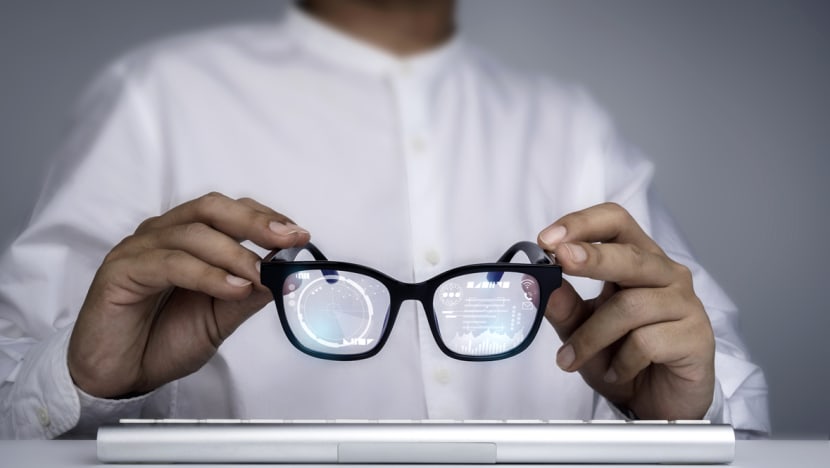Wearing your heart (monitor) on your sleeve: Smart devices and how they are helping in healthcare
One UK organisation that oversees hospitals is trialing such smart wearables, which help doctors see whether they need to adjust treatment plans.

A man holding smart glasses with digital information on a virtual screen. (Photo: iStock/Techa Tungateja)
SINGAPORE: A T-shirt that can monitor the heart, glasses that can analyse images to study vital signs and breathing patterns, and underwear programmed to play soothing music when a rise in stress levels is detected.
These are just some of the smart devices developed in the wearable space in the hopes of saving lives, and one organisation in the United Kingdom (UK) that oversees hospitals has been testing their impact.
Gloucestershire Hospitals NHS Foundation Trust, part of the UK health system, has been partnering with companies to trial such wireless technologies. Ms Claire Richardson, its commercial director, told CNA that such devices are a “key part of the jigsaw” in the efforts to improve healthcare.
In terms of saving lives, wearable devices are already changing patient pathways around being able to monitor and change treatment patterns, she said. She highlighted their use in cancer recovery.
“(In) recovery from surgery, we're using smart wearables to be able to see the effect of the treatment on the patient so we can adjust the treatment pattern and to be able to make sure that it fits with the patients,” she said.
The devices ensure that healthcare professionals are not overstressing the body. If they are recovering better, treatment plans can be changed, she added.
Heart failure patients are also being monitored via such wearables, so they can manage their condition better at home, Ms Richardson said.
DEVICES USE ADVANCED TECHNOLOGY
The advancement in wearable technology means that devices do not have to be clunky.
Smart rings in the market use light-based optical sensors to deliver continuous heart rate monitoring and blood oxygen data.
They may also provide an "energy score" that helps wearers make personalised lifestyle choices.
Sensors have gotten so small that they take up just the space of a fingerprint and can be stuck onto a patient to monitor their vital signs, said Ms Richardson.
“You don't need to worry about charging it. It just sits there like a band-aid would. And it just monitors and transmits the data. That’s where the technology already is,” she said.
Even for devices that require charging, innovations are being made to make them easier to use. University of Massachusetts researchers have invented a biofilm powered by perspiration. It sticks to the skin like a band-aid and converts energy from evaporation into electricity.
Closer to home, scientists from the Nanyang Technological University have developed a "fabric" that turns body movement into electricity. It could one day be integrated into clothes or wearable electronics to power devices on the go.
CHALLENGES SURROUNDING WEARABLE TECHNOLOGY
While such devices can be useful in the healthcare setting, challenges surrounding the meaningful use and sharing of the data collected remain, Ms Richardson said.
“Particularly I would say data and managing the data and information governance is one of the biggest concerns around the NHS. So, we have a lot of work at the moment about being able to protect our patients' data and ensure it can be shared in a trusted and safe environment,” she said.
She added that among the concerns is that wearables with screens are associated with an increase in anxiety for some people. This is given that they are getting regular alerts, for instance, to move and breathe, she said.
However, not all devices have this issue, she said. A smart ring, which Ms Richardson was wearing during the interview with CNA, for example, does not use a screen and monitors silently. It is then up to the user to monitor the data, she said.
Ms Richardson noted that among the useful features of the ring is the indication of sedentary time.
“You can also see your inactive time. This is where you've been sitting at a desk. This is quite important,” she said.
According to the World Health Organization, a sedentary lifestyle increases all causes of mortality, and increases the risk of several illnesses, including cardiovascular diseases, diabetes, osteoporosis and depression.
Still, such devices may, however, never end up being a “must-have” due to accessibility, Ms Richardson said.
“We need to be aware that health needs to be accessible for everybody. There will always be people that potentially can't afford to buy them,” she said.


















